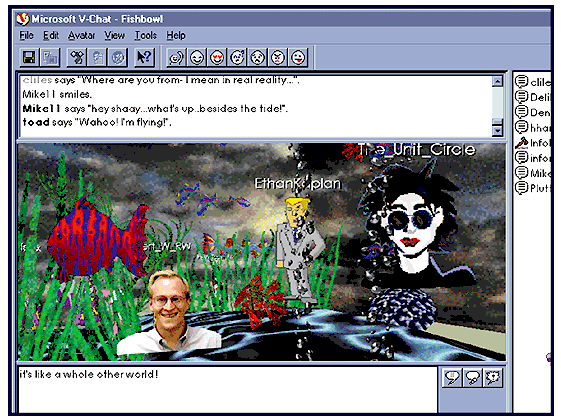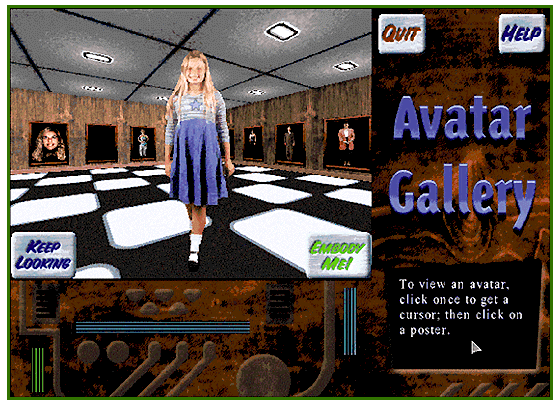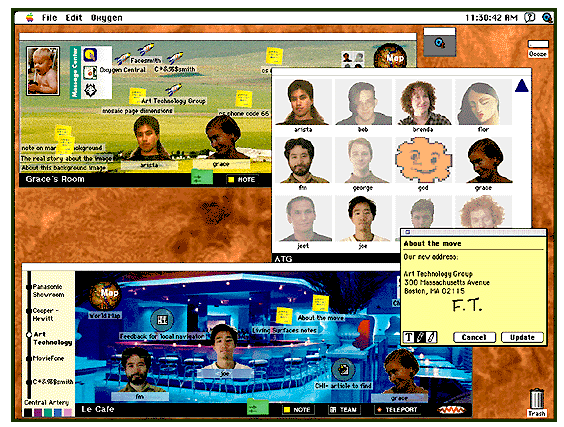| Coming soon to a screen near you: You. Or at least a
facsimile of you. It's called an avatar: a graphical image
of a user — representing yourself or someone else — on a
computer screen. Think of an avatar as your alter ego in
the virtual world of cyberspace. Another kind of avatar is sometimes called an agent, a character, or a bot. This is a graphical personification of a computer or a process that's running on a computer. Avatars are controversial creatures on the cutting edge of user interface design. They're supposed to provide new ways for people to interact with their computers and with other users on a network. By simulating the social interaction of real life, avatars try to present an environment that's more familiar than graphical desktops and command-line prompts. Although limited forms of avatars have been with us for years in videogames, they're rarely seen in other kinds of software. Now that's all starting to change. Last year, Microsoft introduced Bob, an add-on for Windows in which animals and other fanciful characters lend assistance to novice computer users. Some new services on the World Wide Web are making heavy use of avatars. There's even a business groupware product that creates a virtual office populated with employee avatars. And you'll find avatars popping up everywhere in movies, TV shows, and books. Is this the future? Or is it a fad? Some experts predict that avatars will be a common sight on the computer screens of tomorrow. Others say they're too limited and might even be socially destructive. But one thing is clear: Avatars are the focus of intense research in academic and corporate design labs. You'll probably meet one soon. Stranger Than Fiction The driving force behind avatars is the ongoing search for an interface that's easier and more comfortable to use, especially for the millions of people who are still computerphobic. "One of the biggest barriers for beginners, we've found, is the intimidation factor," says Kathleen Schoenfelder, product manager of Microsoft's Social Interface Group, which designed Bob. "We've seen people in our usability tests who literally break down in tears." The earliest computer users were engineers and programmers who were fairly comfortable with command-line prompts. Today, most users are professionals who are fairly comfortable with graphical desktops. But a metaphor based on files and folders means nothing to a five-year-old, and the abstractions of menus and icons are difficult for even some adults to grasp. Avatars can put a friendly face on an inscrutable machine. "People have gone through thousands and thousands of years of evolution that have made us hard-wired for social interaction," Schoenfelder points out. "Characters and avatars take advantage of that hard-wiring." Avatars won't necessarily replace menus, icons, and other elements of GUI computing. Instead, they'll play the role of helpful assistant or guide. Proponents think avatars are tailor-made for the growing virtual communities of on-line services and networks. The avatar bible is Snow Crash, a cyberpunk novel by Neal Stephenson (Bantam Books, 1992). In this near-future story, computer users conduct business in a virtual world called the Metaverse, a successor to today's Web. The Metaverse has streets, office buildings, houses, stores, bars, mass transit, and just about everything else found in the real world — including real people represented by highly realistic avatars. So admired is Snow Crash that one new company — Black Sun Interactive, which makes tools for creating virtual worlds — named itself after the Metaverse cafe where hackers hang out. Another company, Worlds Inc., is building a virtual world on today's Web that's closely patterned after the Metaverse. Worlds is also working with IBM to create digital libraries that allow users to retrieve information and view artifacts in 3-D virtual space. A good example of this technology is Worlds Chat, the company's virtual chat room on the Web. It's basically a graphical version of the multiuser dungeons or domains (MUDs) that have been popular on the Internet for years. You can download the free Worlds Chat software by linking to www.worlds.net. When you run the software, it lets you choose an avatar from a gallery of figures. Then you enter a virtual space station occupied by other avatars. Each avatar represents another person somewhere on the Web. You can maneuver your avatar with the mouse, and you can talk to people by typing messages on your keyboard. It's a virtual cocktail party. This technology was pioneered in the 1980s by an on-line service called Habitat, for the Commodore 64. Now it's moving to a whole new level. Worlds is currently beta-testing a new service known as AlphaWorld; it has 140,000 square miles of virtual territory in which users can construct their own buildings and communities. AlphaWorld will even have virtual stores and banks where people, via their avatars, can transact real-world business. The commercial aspects of AlphaWorld demonstrate that avatars aren't just for fun and games. Proponents believe businesses will benefit from this technology, too. The Virtual Office For two years, employees at Chiat/Day Advertising in New York have been using prototype groupware that simulates a virtual office on a network of Macs and Unix workstations. The groupware environment, called Oxygen, was designed by Art Technology Group, a Boston-based spin-off of MIT's Media Lab. Later this year, the developers plan to introduce a commercial version of Oxygen that can support hundreds of thousands of users across WANs and the Internet. Oxygen contains virtual rooms where employees can work on group projects. To share project-related information, for example, someone leaves a file icon in one of the virtual rooms. Other people can enter the room and retrieve the file without knowing exactly where on the LAN the file really resides. Employees can even dial into the virtual office from a laptop on the road. To set up a conference call, they simply click on the avatars of the coworkers they want to include; Oxygen is tied into Chiat/Day's Rolm PBX. The avatars in Oxygen are disembodied faces. Employees are free to use digitized photographs, or any graphics they want, for their avatars. "Just as people like to personalize their offices with pictures of their dog, we wanted to give them the ability to personalize their images," explains Jeet Singh, cofounder and CEO of Art Technology Group. "Like maybe today I feel like Superman. Or maybe I feel like an alligator." However, this raises one of the several controversies about avatars: reality versus role-playing. A realistic avatar might help you identify another person you meet in virtual space, but someone could also wear an avatar as a disguise. What if an employee impersonates another employee? What if someone chooses an avatar that other workers find distracting, disgusting, or politically incorrect? Most businesses would frown upon someone who showed up for work every day in a Halloween mask; should avatars be allowed to flout the corporate dress code? Singh has considered this problem. "Some companies might say, `You cannot change your avatar, you must use the official picture we took when we hired you.' Other companies won't care. When this software is running at IBM, all the avatars will probably be wearing ties and blue suits." Of course, masquerading is rampant in on-line chat rooms. People who wouldn't dare to cross-dress in real life frequently pose as the opposite sex while on-line. In Worlds Chat, the avatar gallery lets you indulge your fantasies by posing as anything from a businessman to a butterfly. Before long, there may even be class distinctions between avatars. In Snow Crash, users who log onto the Metaverse from cheap public terminals appear as pixelated, monochrome avatars derisively referred to as "black-and-white people." Will tomorrow's status-seekers hire artists to draw custom avatars adorned in Armani suits and wearing Rolex watches? Bob Rockwell, chief technology officer of Black Sun Interactive, thinks people will gradually address these issues by inventing new social rules for avatars. In recent years, people have developed new conventions for E-mail that are slightly different from the rules that govern how they handle written correspondence or phone calls. Rockwell says avatars will likewise spawn their own social etiquette. "For instance, lurking is necessary," says Rockwell. "Smart users lurk for a while in a chat room before they shoot their mouths off. But lurking at a real-world cocktail party is considered impolite. Lurking is eavesdropping. We need a way to represent lurking on-screen, maybe with grayed-out avatars, so you'll know people are there but aren't actively participating." Revenge of the Turing Test Agents, bots, and characters raise even more questions. Already, some people in virtual chat rooms occasionally mistake a computer-controlled bot for a human-controlled avatar — which might say more about the intelligence of the beholder than it does about the bot. But some people don't think it's funny. Designers are keenly aware that many people react negatively to personifications of computers. "Some people are very strongly against it because they feel it's misleading, that a computer is not a human, and that to give a computer a human appearance could mislead the user into giving false attributes to the machine," says Don Norman, a user interface expert and vice president of Apple's Advanced Technology Group. Apple took great pains to design a generic-looking face for its PlainTalk speech-recognition software. Moreover, the PlainTalk face doesn't personify the computer; it's really a cue that tells users when the PlainTalk software is ready for commands or when it can't recognize a command. "It doesn't pretend to have any intelligence," says Norman. The ideal user interface, he says, makes the computer invisible, not more visible. If you're writing a letter, you see a notepad; if you're balancing your bank account, you see a checkbook. Norman thinks today's interfaces are far too complex, and that avatars threaten to add still more complexity by interposing another layer of indirection between users and their tasks. Nevertheless, avatars have an allure that won't go away. If nothing else, they'll probably thrive in the new chat rooms on the Web. And the engineers who are designing virtual worlds around avatars can't resist the temptation to improve upon reality. If the mood seizes you, why not appear as a man-eating plant? Why ride a bus when you can use a transporter? Why wait in line at the bank if an agent can transact your business on-line? "We have to design the virtual worlds to make as little as possible impossible," says Rockwell of Black Sun, "and as much as possible possible." Where to Find
|


